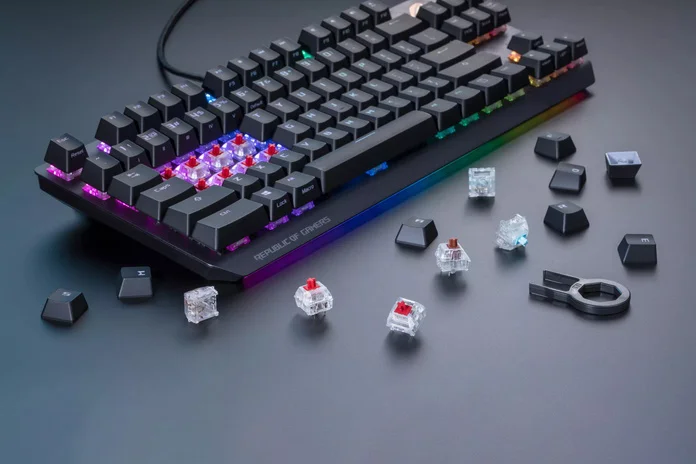Everything that makes a keyboard or mouse great for gaming also makes it great for business. Consider that a keyboard handles hundreds or thousands of keystrokes in a day whether you’re typing a report or playing an FPS. And then there’s the mouse moving perpetually across your desk with little flicks of your wrist. With just a little effort, the cursor must travel across one or more massive monitors. Whether the monitors display a vast spreadsheet of cells or a territory map in a turn-based strategy game, you want the mouse to move the cursor quickly and precisely. Gaming mice offer that speed and precision every time.
Consider, also, that workers and gamers want the same things from their equipment in the long run. Both want to customize buttons and macros to improve workflow or reduce reaction time. Both want their wrists and fingers to finish the day ache-free. And both want, above all, for their equipment to hold up over time. Experienced gamers know that gaming peripherals are engineered to endure punishment above and beyond what standard computer equipment can handle. Business leaders should take a page from the gaming playbook and consider issuing gaming keyboards and mice to their employees — especially those workers for whom precision, versatility, and durability all add up to increased productivity.
Heavily used peripherals feel bad and can fail prematurely
Most of us have learned how computer equipment feels when it finally starts to fail. Desk workers and college students often use equipment shared by other students and employees, equipment that suffers heavier-than-average use and abuse. When this equipment prematurely reaches the limits of its lifespan, the story gets sad yet familiar: mushy keys, unregistered keystrokes, jumpy cursors, and jittery mice.
The cause? For typical office keyboards, problems can arise over time with the thin membrane layers that communicate keystrokes to the PC. Businesses are often tempted by membrane keyboards due to their low cost and quiet operation, yet the membranes degrade over time, and they disintegrate fastest under the most frequently used keys. In the early stages of failure, the result is uneven feedback from one key to the next, which can distract or nag typists. Some keystrokes eventually cease to register at all, ending the usable life of the keyboard, which just might end up in a landfill.
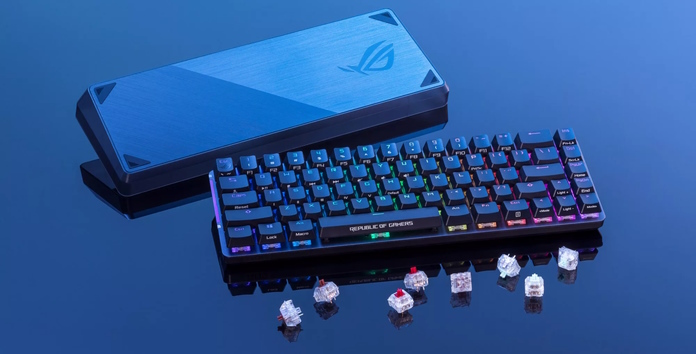
If heavy use is the danger, then durability is the protection against premature equipment failure. And when it comes to durable computer equipment, nothing surpasses the keyboards and mice preferred by the most discerning gamers. If a standard keyboard is the beige sedan that gets drivers to work and back, then a gaming keyboard is the sports car you take for a weekend pleasure cruise. It will be finely tuned and built to run endlessly with a little regular maintenance.
What makes gaming peripherals more durable
Whereas membrane keyboards rely on a piece of plastic running under all the keys that will degrade over time, high-quality gaming boards deploy mechanical switches beneath every single key. The ROG Falchion NX, for example, uses ROG NX mechanical switches that are precision engineered to endure over 70 million keystrokes. For gamers, that’s a lot of walking and crouching; for businesses, that’s years of memos and reports.
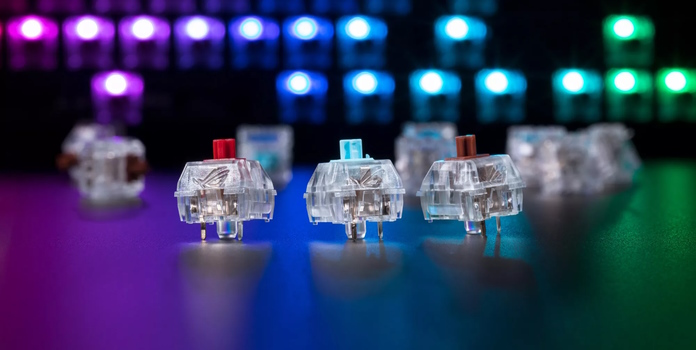
The same goes for a mouse. Professional gamers can click their mouse buttons a thousand times or more in a single session. That’s why the most durable gaming mice use carefully engineered switches to handle tens of millions of clicks. Some gaming mice, like our ASUS TUF Gaming M4 Air, also come with a cable engineered for minimal interference with movement and maximum durability, thanks to the cable’s materials: nylon paracord sleeved around flexible PVC-insulated wiring.
At this point in the discussion, you shouldn’t be surprised to learn that the bodies of the highest-quality gaming keyboards use metal alloys for key structural elements. Metal lasts longer than plastic and takes more punishment. In other higher-end peripherals, you’ll find key caps and button covers constructed of a plastic called PBT. Experienced users know this plastic has a textured feel under your fingers and isn’t glossy, which allows the peripheral to resist damage from the oils of human skin. We’ve all probably noticed how normal plastic, over time, develops a shiny, almost greasy surface where it’s touched most frequently.
In addition to resisting wear and tear from human hands, a good gaming peripheral also delivers waterproofing and dust resistance that meets the IP56 standards. Our TUF Gaming line of keyboards makes this grade, which certifies that they’re protected against “limited dust ingress” and high-pressure jets of water from any direction. Imagine never worrying about employees accidentally spilling a cup of coffee or a can of soda on their keyboards again.
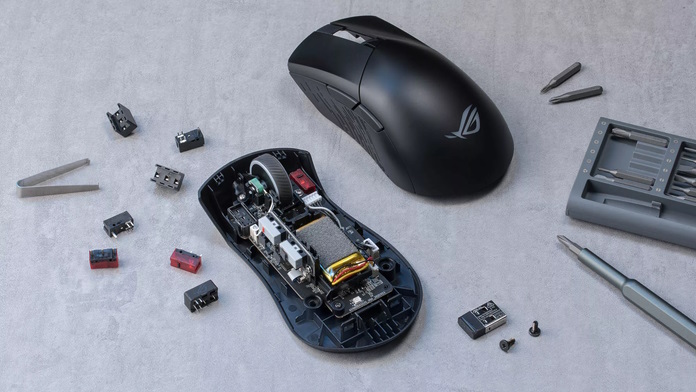
High-quality, high-durability peripherals can mean benefits for the planet, too. Our high-end ROG Azoth makes it easy to fix a worn-down switch with hot swappable switches in 75% of the keys. Likewise, gaming mice often make customization easy with swappable switches for buttons. Many modern ROG gaming mice, including the Chakram and Gladius, have an ROG-exclusive push-fit switch socket design to make replacing the switch effortless. Instead of dropping a malfunctioning mouse or keyboard into the landfill, you can throw away a switch and continue using the peripheral for tens of millions more clicks and taps.
What makes gaming keyboards more precise
Beyond durability and environmental benefits, gaming peripherals offer the highest possible precision. Gamers spend a lot of time inside a digital war zone, where bullets fly over their heads or explosions rock the ground beneath their feet. If you’re dodging enemy fire while crouch-rolling across an open line and jumping to your feet in time to take the kill-shot on a sniper sixty yards away, every fraction of a second counts. The mouse needs pixel-perfect accuracy. The keyboard needs to register every keystroke with just the right amount of resistance.
How much of this precision matters in the relatively tame environment of an office? More than you might expect. Consider those moments when your keyboard behaved strangely. Maybe you rapidly typed several words, but some letters never appeared. Or maybe you were deep into a programming run and entered one of the hotkey combinations you’ve committed to memory, only to find the command never executed. Professional creators and video editors who rely on multiple, complex hotkey combos may also have noticed that some keyboards fail to register these commands. This phenomenon is called “ghosting,” and gaming keyboards take anti-ghosting technology to the extreme.
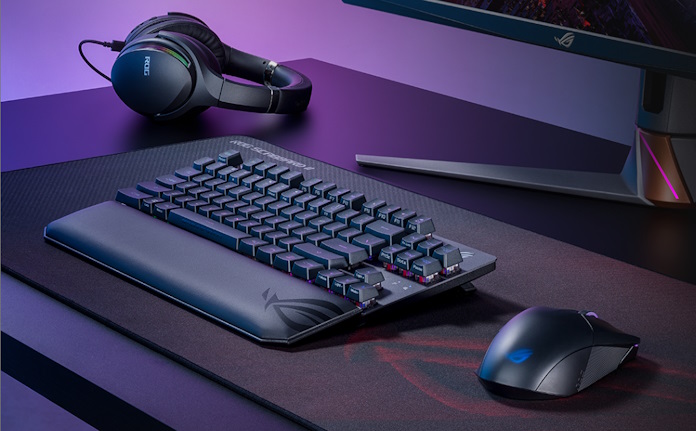
Without getting too technical, let me say that many standard keyboards can stop registering keystrokes whenever multiple keys are pressed simultaneously. The keystrokes that don’t show up onscreen are said to have been “ghosted,” and it happens for a variety of reasons.
Whatever the cause, ghosting is a problem that gamers won’t tolerate. They insist on N-key rollover (or NKRO for short), which means the keyboard registers unlimited simultaneous keystrokes and reports all of them to the computer. Workers can type as many keys as possible, as quickly as possible, using tons of memorized hotkey combinations for their work, all without overwhelming these boards.
What makes gaming mice more precise
Advances in precision have come even farther for mice. Take our ROG Harpe Ace Aim Lab Edition, for example. Like many gaming mice, its feet (where the mouse contacts the mousepad or desk) are made of PTFE (Polytetrafluoroethylene, commonly known as Teflon). The mouse slides with almost no friction. Since the Harpe weighs just 54 grams, it can be moved all day with little to no fatigue.
But where the mouse communicates with the computer, things get even better. The speed at which a standard mouse communicates inputs to the computer (called the polling rate) is 125 Hz, or one signal every eight milliseconds. By contrast, the polling rate for a great gaming mouse is 1,000 Hz, or one signal per millisecond — a thousand per second. This boosts the sensitivity of gaming mice off the charts.
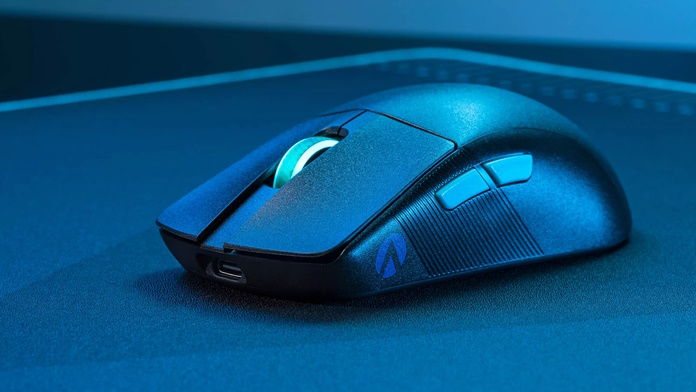
Your mouse’s sensitivity is measured in dots per inch (DPI), referring to how far the cursor moves onscreen for every inch the mouse moves on the table. An average mouse’s DPI ranges from 800 to 1600. The ROG Harpe Ace Aim Lab Edition offers a 36,000 Hz AimPoint optical sensor. Working with large spreadsheets, elaborate graphic design projects, or widespread multi-display setups suddenly requires a lot less movement of the mouse. A quarter-inch flick sends the cursor flying farther and faster than you’ve ever seen.
But what if you want to slow down the action onscreen? Don’t worry. Gamers work at a variety of speeds too, from the rapid mayhem of a firefight to the precision required in lining up a sniper shot. That’s why gaming mice like the ROG Harpe have a switch on their body to allow users to adjust DPI on the fly, meaning the cursor’s speed and distance traveled onscreen are entirely under your control from moment to moment. The ROG Harpe also adds anti-slip mouse grip tape to keep the action well in hand.
Power users will love customizing their gaming peripherals

We’ve already seen the benefits that n-key rollover offers to power users who program macros and hotkeys into their computers. For even more efficient workflow, gaming peripherals afford their users exquisite customizability. The ROG Chakram gaming mouse is a good example. This mouse has a programmable, removable joystick. Analog mode simulates a classic thumb stick that will be familiar to players of consoles from the NES Max to the PlayStation 5. Digital mode allows users to program commands into the four different directions, such as opening or closing programs, scrolling webpages, or — of course — reloading your weapon in an FPS.
Power users who prefer buttons to joysticks can check out the ROG Spatha, with twelve buttons that are fully programmable. Both mice and keyboards often come with onboard memory that allows users to set up different profiles, each with its own set of macros and hotkeys. And our ROG Armoury Crate app allows for intuitive, easy customization of gaming peripherals on any PC.
Remote and hybrid workers will love the flexibility
It is no secret that today’s office workers are more mobile than ever. By the fourth quarter of 2022, a Statista report found that 53 percent of U.S. workers said they were working in a hybrid arrangement. Gaming peripherals can help these hybrid employees too. We’ve already written about the benefits to flexibility and productivity that portable displays can offer hybrid workers. Gaming mice with tri-mode connectivity afford similar flexibility, allowing users to connect them to the computer in three different ways: Plug in a cord as normal, or detach the cord and connect with Bluetooth, or — as with the ROG Harpe — use low-latency 2.4 GHz RF dongle.
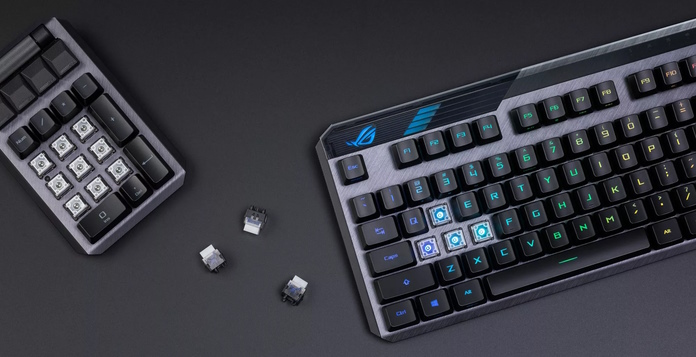
Meanwhile, gaming keyboards like the ROG Claymore take flexibility even further. In addition to wired and wireless connectivity modes, the Claymore has built-in cable routing grooves for effortless cable management. There’s also a detachable micro-USB cable for when you want to connect wirelessly. Finally, in a move toward ultimate versatility, the Claymore includes a detachable number pad that can be moved from the right side of the board to the left, making it a strong contender for data entry jobs of every type.
And if you ever notice a second USB port on your gaming keyboard, it might be a USB 2.0 passthrough port. This handy feature allows you to plug a microphone, thumb drive, external hard drive, mouse, or anything else directly into the keyboard rather than leaning over to the computer — or, even more inconvenient, a mini-PC mounted on the rear of the display. This is the sort of small touch that, as with all luxuries, you didn’t know you needed until you had it.
Every worker will enjoy the superior ergonomics
So don’t be surprised if you find yourself wanting to take your gaming keyboard everywhere. A big part of what addicts users to these keyboards is the thoughtful, ergonomic design. To start with, the industry offers five different styles of key switches that allow a range of typing experiences. Our ROG Strix Flare II Animate offers a wide variety of keyboard switches. Each has its own set of advantages and disadvantages, but some of these switches seem custom-built for a crowded office environment.
For instance, linear switches give you smooth, consistent typing with no distracting feedback. These key switches will be valued highly in offices with an open design, where noisy typing can distract or frustrate coworkers, because linear switches make minimal noise other than a typical bottom-out sound. For even stealthier typing, you can opt for silent tactile switches. They feel like membrane keyboards without the sensation of mushy rubber, since they use silicone pads to dampen the sounds associated with mechanical switches.
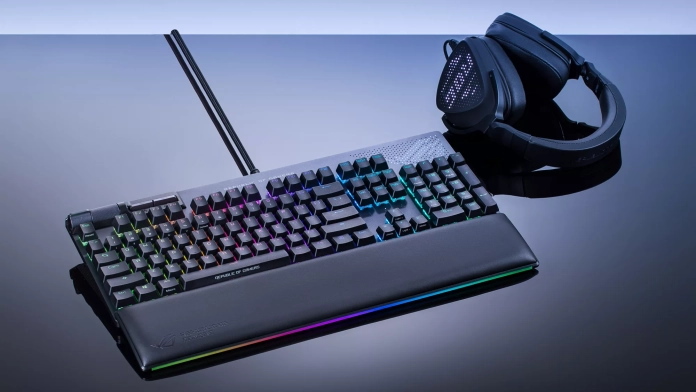
At the other extreme are clickity blue switches, which do exactly what you think. These keyboards will remind more mature office workers of those IBM mechanical boards from the 1980s and 1990s, which have inspired a cultlike devotion in a new generation of typists. Devotees love the satisfying feedback and clicking sound they experience with every keystroke. (Ask your favorite keyboard nerd about “Nixie” and watch their eyes light up.)
For a middle ground between these two extremes, opt for the brown switches, either our in-house ROG NX switches or from Cherry. They have a rounded bump offering tactile feedback without the annoying clicks. Users will feel this bump soon after starting to press the key but before the key bottoms out, just at the point where the computer registers the keystroke. Speed typists can train themselves to stop depressing the key at this point of feedback so they never need bottom out their keys again. The result is faster typing and less fatigue for fingers and hands after a long day of writing or coding.
Designers of gaming keyboards and mice all have one ultimate goal: To make the point of contact between you and your PC as smooth as possible. They remove all friction from your entrance into the digital domain. Likewise, the best peripherals are designed, like any good tool, to become an extension of your hand. After you work with these tools long enough that your hands have memorized their contours, you reach the point where you cease to notice the mouse and keyboard at all.
Everyone will appreciate the artistry
One more thing separates gaming peripherals from standard office computer equipment. They’re beautiful. It might sound funny, since “beauty” isn’t the prime value in most offices. But every gaming mouse and keyboard comes with a lightshow.
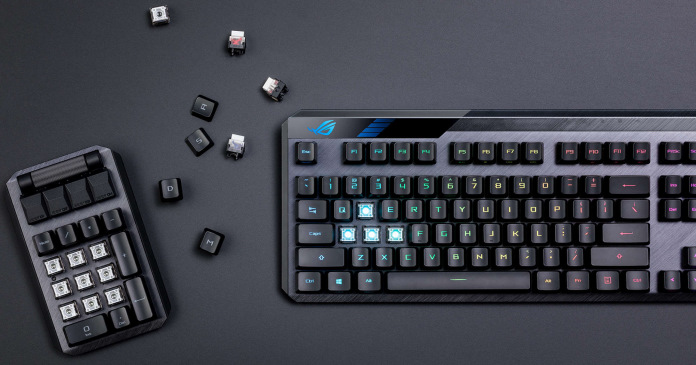
Many laptop users will be familiar with backlit keyboards. Gaming keyboards take illumination to the next level, offering a full range of colors in the Red-Blue-Green spectrum. If you want to maintain a professional atmosphere, rest assured that the lightshow is fully customizable. In fact, different profiles can be programmed into the peripherals with different lightshow settings. You can create a range of moods for different parts of the workweek, from the somber sobriety of a Monday morning, to the Thursday afternoon cake break, to the Friday evening celebration of an oncoming weekend. When the manager calls for everyone’s attention, keyboards like the ROG Strix Scope offer a stealth key with one-tap hiding of all apps and muting of all audio.
Pick a model with customizable per-key backlighting, and the lightshow can be practical, too. Your employees can highlight specific keys on their keyboards with a certain color to help them find the exact tool or hotkey that they’re looking for. For workers using software with a large range of keyboard commands, that can be an efficiency booster, especially for new employees.
Whether you want to work hard or play hard, whether you want to have the highest quality computer equipment or just enjoy the best performance from your everyday tools, you should consider gaming peripherals for your office. You’ll also enjoy lowering your carbon footprint by putting less waste into landfills, along with an extended replacement cycle for your employees’ gear thanks to the increased durability. Gaming mice and keyboards cost a little more up front, like any top-of-the-line car. But we think the investment appreciates in time, with greater pleasure, durability, and precision over the long run.

